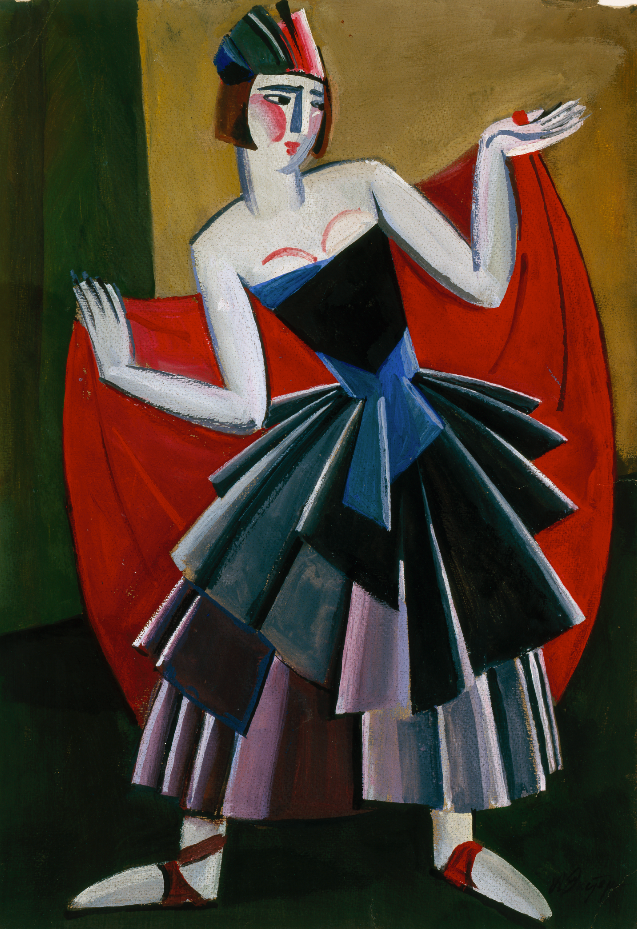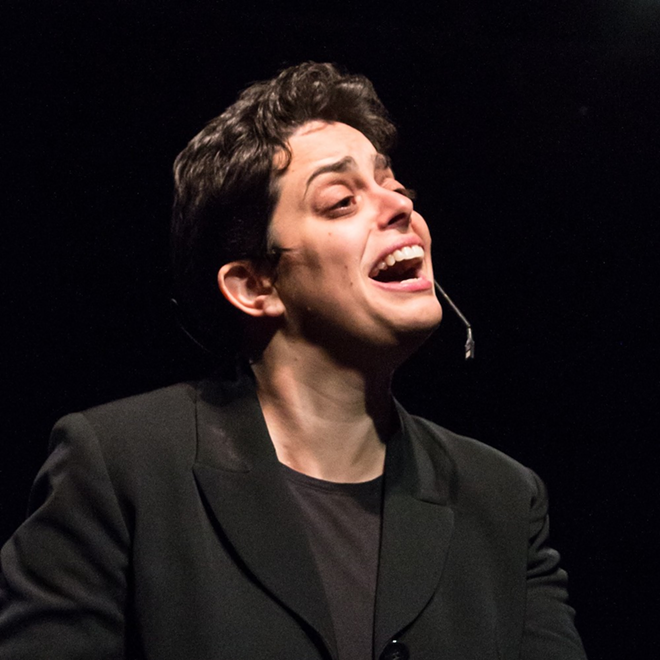
Before it closed temporarily amid concerns around the coronavirus, The Museum of Fine Arts’ “Art of the Stage” told many stories, the broadest of which is the history of theater itself. Each production referenced tells its own story, from the story of Susan B. Anthony and women’s suffrage in Gertrude Stein and Virgil Thomson’s opera “The Mother of Us All” to the biblical story of “Salome” as told by Oscar Wilde.
Let’s focus on two: the stories of Salome and Scheherazade, which resonated most with local Arab American artist Andrea Assaf.
“[Scheherazade and Salome] are both female figures,” Assaf told Creative Tampa Bay. “It’s debatable whether or not they’re historical figures or whether they’re more folklore, but so much story swirls around them.”
Salome makes her first appearance in the Bible as the young woman who requests the head of John the Baptist on a platter. In the biblical telling, King Herod wants to marry his brother Phillip’s wife, Herodias. John tells him, “It is not lawful for you to have your brother’s wife,” and Herodias is pissed. She wants John dead, but she doesn’t think her new husband will kill him for her. Eventually, her daughter Salome makes the request. Matthew 6:22 says, “When the daughter of Herodias came in and danced, she pleased Herod and his dinner guests. The king said to the girl, ‘Ask me for anything you want, and I’ll give it to you.’”
Salome asks her mother what she should request, and of course Mom in her great pettiness suggested she ask for the head of John the Baptist. So she did, and the rest is history, legend, or whatever you want to call it. The story fits into a single page of the New Testament. The Bible tells us very little about Salome, so people started making up their own details.
“Fascinating to literary artists from ancient times to the present, the ‘Salome’ narrative evolves in a continually developing dance,” writes Carmen Trammell Skaggs in the scholarly article, “Modernity’s Revision of the Dancing Daughter: The Salome Narrative of Wilde and Strauss.”
Unfortunately, the most influential retellings, by Oscar Wilde and Richard Strauss, are riddled with racial stereotypes. Let’s start with Oscar Wilde’s “Salome,” published in 1891, and known for its Orientalism, generally described as “a way of seeing that imagines, emphasizes, exaggerates and distorts differences of Arab peoples and cultures as compared to that of Europe and the U.S. It often involves seeing Arab culture as exotic, backward, uncivilized, and at times dangerous.” Think snake charmers, veiled women, harem pictures, and basically every imaginable stereotype an Arab-American artist might find offensive all wrapped in a bundle.
In Wilde’s version, Salome is characterized as a morally-depraved sex kitten, an exotic beauty who immediately captures the Young Syrian’s attention, but cannot capture John the Baptist’s heart, no matter how hard she tries to corrupt him.
Unfortunately for John the Baptist, Salome doesn’t deal well with rejection. In Wilde’s version, Salome doesn’t request John’s head to appease her mother; she requests John’s head because he rejects her. Wilde’s play was extremely popular in Germany—popular enough that German composer Richard Strauss decided to make an opera out of it. Strauss’s 1905 opera kept about a third of Wilde’s text, put it to music, and added a heaping tablespoon of anti-Semitism. In Strauss’ opera, the moral degenerates are now the Jews of the East, hysterical and quarreling throughout the production.
Sadly, Skaggs posits, “the dancing daughter we envision in the 21st-century is a product of the mythic figure created by Wilde and Strauss, not the one encountered in the Biblical accounts in the gospels of Mark and Matthew.”
If ever a character was in need of a 21st-century rewrite, it’s Salome, who went from having no personality or description at all in the Bible to becoming a racial stereotype in Wilde and Strauss’ reinterpretations.
Now let’s talk about Scheherazade.
“[She] comes out of completely Middle Eastern tradition in stories and folklore from the Arab world and Persian,” Assaf told Creative Loafing Tampa Bay.
“She’s also been rewritten several times, and she’s been rewritten through the eyes of the British Empire and colonialism and the male gaze.”
Scheherazade is the main character in “One Thousand and One Nights/Arabian Nights,” a collection of Middle Eastern folk tales originally told in Arabic. How can there be a main character in a collection of stories? It’s a narrative device called framing. Scheherazade’s tale is the frame of the story through which the other stories are told.
In short: King Shahrayar, who rules in India and China, marries the wrong woman. After she cheats on him, Shahryar decides to never trust women again.
“I, Shahrayar, shall each night marry a virgin, kissed only by her mother. I shall kill her the following morning and thereby protect myself from the cunning deceit of women, for there is not a single chaste woman on this earth!” he pronounces.
Spoiler alert: Eventually they can’t find any more virgins.
This is when Scheherazade volunteers to be Shahrayar’s wife, but she plans to tell her new husband a story each night, but to always end on a cliffhanger. If he wants to know the ending, he has to postpone her execution by another day. Each night, Shahrayar spins a tale of the oppressor vs. the oppressed.
“Through all these stories, she is working on him,” writes Joe Fassler for the Atlantic. “She chooses stories that mirror her predicament. All the characters are pleading for life, in a way.”
This goes on for 1001 nights, after which Shahrayar finally spares Scheherazade’s life for good. In the original, Scheherazade is brave and clever. The Ballets Russes’ 1911 production of “Scheherazade,” however, has nothing to do with oppression or storytelling. It’s simply “a ballet set in an Oriental harem,” writes Nikoo Paydar in a 2013 Artl@s Bulletin. In other words, an interesting character was replaced with a collection of stereotypes that paid no mind to the original story.
Rosie Thomas, in “Scheherazade’s Children,” calls the Ballet Russes’ production part of a second wave of European orientalist fantasy which happened in the early decades of the 20th century.
“Shamelessly dispensing with the clever woman storyteller—Scheherazade herself—the ballet was confected around one scene of the introductory frame story, which reveled in the despot, slave, harem, and orgy motifs that so excited the European imagination,” Thomas writes.
Basically, 19th and even 20th-century European depictions of Salome and Scheherazade leave something to be desired.
“I’m just really interested that both of these women have shown up in this art exhibit and through theater, which is my background,” Assaf told CL. “I’m interested in, as an Arab American woman now, in the 21st century, how to counter those figures. What do they have to say to us now? What do I have to say to them?”
Support local journalism in these crazy days. Our small but mighty team is working tirelessly to bring you up to the minute news on how Coronavirus is affecting Tampa and surrounding areas. Please consider making a one time or monthly donation to help support our staff. Every little bit helps.
Follow @cl_tampabay on Twitter to get the most up-to-date news + views. Subscribe to our newsletter, too.


